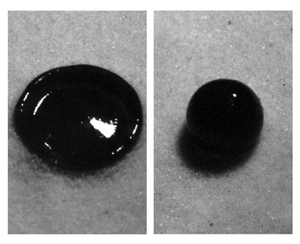Article contents
Hydrogel sphere impact cratering, spreading and bouncing on granular media
Published online by Cambridge University Press: 27 October 2021
Abstract

The impact of a hydrogel sphere onto a granular target results in both the deformation of the sphere and the formation of a prominent topographic feature known as an impact crater on the granular surface. We investigate the crater formation and scaling, together with the spreading diameter and post-impact dynamics of spheres by performing a series of experiments, varying the Young's modulus  $Y$ and impact speed
$Y$ and impact speed  $U_{0}$ of the hydrogel spheres, and the packing fraction and grain size of the granular target. We determine how the crater diameter and depth depend on
$U_{0}$ of the hydrogel spheres, and the packing fraction and grain size of the granular target. We determine how the crater diameter and depth depend on  $Y$ and show the data to be consistent with those from earlier experiments using droplets and hard spheres. Most specifically, we find that the crater diameter data are consistent with a power law, where the power exponent changes more sharply when
$Y$ and show the data to be consistent with those from earlier experiments using droplets and hard spheres. Most specifically, we find that the crater diameter data are consistent with a power law, where the power exponent changes more sharply when  $Y$ becomes less than 200 Pa. Next, we introduce an estimate for the portion of the impact kinetic energy that is stored as elastic energy during impact, and thus correct the energy that remains available for crater formation. Subsequently, we determine the deformation of the hydrogel spheres and find that the normalized spreading diameter data are well collapsed introducing an equivalent velocity from an energy balance of the initial kinetic energy against surface and elastic energy. Finally, we observe that under certain intermediate values for the Young's modulus and impact velocities, the particles rebound from the impact crater. We determine the phase diagram and explain our findings from a comparison of the elastocapillary spreading time and the impact duration.
$Y$ becomes less than 200 Pa. Next, we introduce an estimate for the portion of the impact kinetic energy that is stored as elastic energy during impact, and thus correct the energy that remains available for crater formation. Subsequently, we determine the deformation of the hydrogel spheres and find that the normalized spreading diameter data are well collapsed introducing an equivalent velocity from an energy balance of the initial kinetic energy against surface and elastic energy. Finally, we observe that under certain intermediate values for the Young's modulus and impact velocities, the particles rebound from the impact crater. We determine the phase diagram and explain our findings from a comparison of the elastocapillary spreading time and the impact duration.
JFM classification
- Type
- JFM Papers
- Information
- Copyright
- © The Author(s), 2021. Published by Cambridge University Press
References
REFERENCES
- 8
- Cited by



